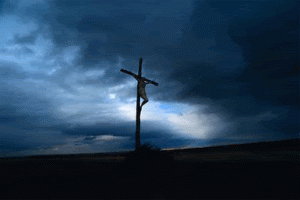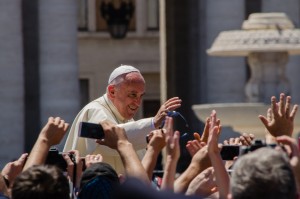 He was crucified also for us. It’s the for us which gives us trouble. Those two words are in a different register from the rest of that sentence. The evangelical missioner turns up on the doorstep and asks the householder if he knows the Lord Jesus Christ. The un-churched householder is embarrassed and perplexed. What is it like, this embarrassment and perplexity? It is as if a person unacquainted with music were to be asked out of the blue what he makes of Beethoven’s string quartet opus 130. He makes nothing of it. How could he? His embarrassment and perplexity do not mean that he is insensitive or unintelligent, only that he has not had the sorts of musical experiences which alone can lead him to an appreciation of the opus 130. It sounds strange to him and he cannot make sense of it. As Wittgenstein would say, he is unacquainted with the form of life or language-game that is music. How to provide the experience he requires? The music teacher might begin by playing a recording of an earlier, more straightforward, Beethoven quartets – say one of the opus 18 set. In fact, he might go back to things earlier still, such as Haydn’s opus 76 number 4 or Mozart’s K 458. And the language-game of music is not just string quartets. There is the habit of going to live concerts, reading the notes provided in the programme, learning something about the lives of the composers and the times and places in which they lived; perhaps most important of all, listening to a great variety of pieces and especially listening to the same piece again and again until it is no longer strange but becomes familiar. This is akin to finding a new friend who, given time, becomes a close friend, someone to whom one turns eagerly, affectionately and with gratitude.
He was crucified also for us. It’s the for us which gives us trouble. Those two words are in a different register from the rest of that sentence. The evangelical missioner turns up on the doorstep and asks the householder if he knows the Lord Jesus Christ. The un-churched householder is embarrassed and perplexed. What is it like, this embarrassment and perplexity? It is as if a person unacquainted with music were to be asked out of the blue what he makes of Beethoven’s string quartet opus 130. He makes nothing of it. How could he? His embarrassment and perplexity do not mean that he is insensitive or unintelligent, only that he has not had the sorts of musical experiences which alone can lead him to an appreciation of the opus 130. It sounds strange to him and he cannot make sense of it. As Wittgenstein would say, he is unacquainted with the form of life or language-game that is music. How to provide the experience he requires? The music teacher might begin by playing a recording of an earlier, more straightforward, Beethoven quartets – say one of the opus 18 set. In fact, he might go back to things earlier still, such as Haydn’s opus 76 number 4 or Mozart’s K 458. And the language-game of music is not just string quartets. There is the habit of going to live concerts, reading the notes provided in the programme, learning something about the lives of the composers and the times and places in which they lived; perhaps most important of all, listening to a great variety of pieces and especially listening to the same piece again and again until it is no longer strange but becomes familiar. This is akin to finding a new friend who, given time, becomes a close friend, someone to whom one turns eagerly, affectionately and with gratitude.
He was crucified also for us is meaningless taken out of the language-game of Christian doctrine. By the way, the phrase “language game” does not imply anything trivial or unreal. It is simply the English translation of Wittgenstein’s original German. It means a whole world, a world which one enters and begins to feel one’s way around. The Christian language-game follows precisely the form of the musical language-game. It involves going to church, studying the Scriptures, receiving the Sacrament, hearing sermons, saying prayers, learning the significance of Christian symbols and becoming acquainted with all the other Christian doctrines: he was incarnate by the Holy Ghost of the Virgin Mary and was made man.
And just as the opus 132 was preceded by the opus 18, by the quartets of Haydn and Mozart and indeed by a whole long musical history, so He was crucified for us cannot be understood without an acquaintance with the Genesis story of the Fall of Man, Original Sin and the prophecies of Christ’s death in Isaiah, such as:
He was wounded for our transgressions, he was bruised for our iniquities: the chastisement of our peace was upon him; and with his stripes we are healed.
There are a thousand ways to approach the doctrine which says He was crucified also for us. Asking questions of the priest. Joining a Christian Bible study group. Even, for one at a loose end on a wet afternoon, there is the opportunity to read what the biblical critics say about it in their so called theories of the Atonement:
Christus Victor – that through his death Christ triumphed over the supernatural powers of evil.
Penal substitution – that God punished Christ for the sins that are ours, so that we might be saved.
Ransom – that Christ’s death was the ransom God paid to the devil to secure our release.
Exemplarence – Abelard’s view that Christ’s willing death was an example to us of self-giving love.
Whatever anyone makes of these theories, it is vital to notice that they are only theories, conjectures made by the mind of man. They are not to be confused with the original doctrine. And no one was ever saved by a theory. But it is even more important to know that the doctrine itself does not exhaust He was crucified also for us of its meaning. For doctrines are symbols. The Greek word symbolon was used to describe a clay seal that was broken in half and given to two people, serving as a sign of recognition between them. For instance, if I left a valuable possession or made a financial deposit with a shopkeeper, we would break the seal and he would take one half and I would keep the other. Later, when the two pieces were drawn together and matched up perfectly, it confirmed my identity as the true owner and my contract with the shopkeeper.
So when Christians describe doctrine as symbols, part of what they mean is that doctrines are signs of Christian identity and communion among all believers. And when the Creed you recite matches up with the Creed of the early church, you could know with confidence that you were sharing in the faith whose centre is Jesus himself and which was proclaimed by the apostles. In Wittgenstein’s terms, the doctrines are what confirm that we all belong in the one Christian language-game.
Doctrines are symbols and again we must remember that they are to be held fundamentally but not literally. As Wittgenstein would say, they are the limits of what can be said. And beyond that which is said are those things which can only be shown. And what is shown requires someone to see it. But what we see is, as St Paul said, through a glass darkly. The doctrines are wonderful, sure enough, but they are not the total reality. This total reality cannot be apprehended by the mind of man – because the total reality is supernatural and therefore transcendent. What we are, we know. What we shall be, it doth not yet appear.
We live within this world of symbols and doctrines which, as the author of The Epistle to the Hebrews wrote, are types and shadows.
We should not feel uncomfortable about this, as if we thought we were being somehow sold short. We have to be content to have as much of the truth as our natural minds can accommodate. And we should love the doctrines and cling to them. Think again of the doctrine as a symbol and think of the wedding ring which is not the whole of the marriage but which is a symbol, a real and loving reminder of the whole marriage.








Comments